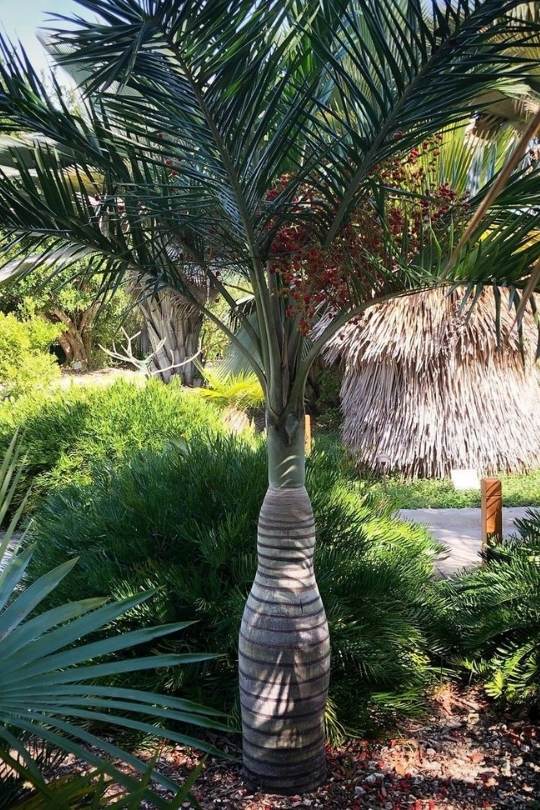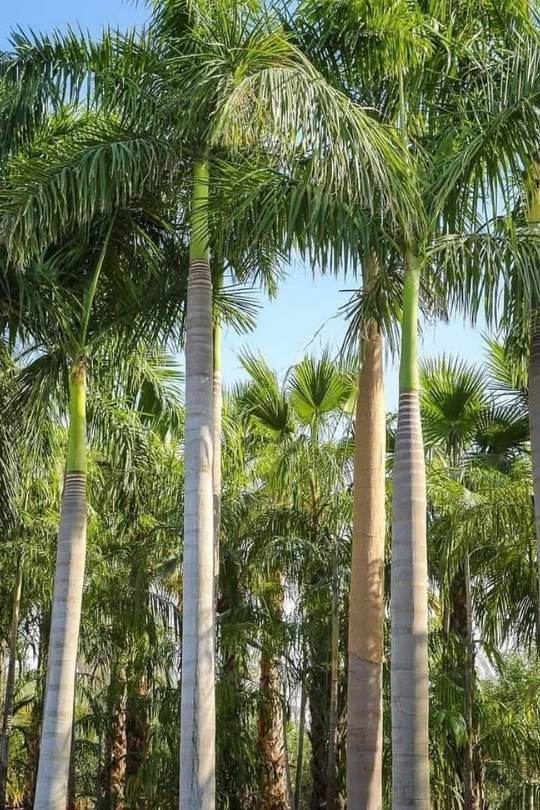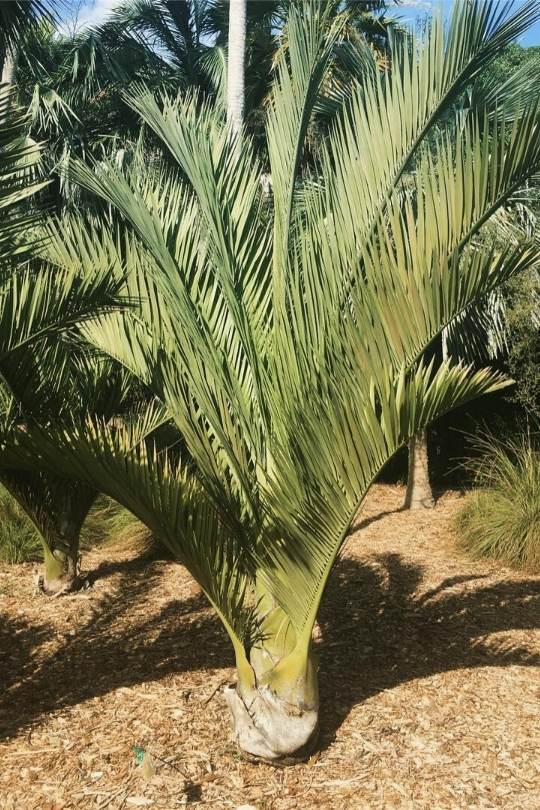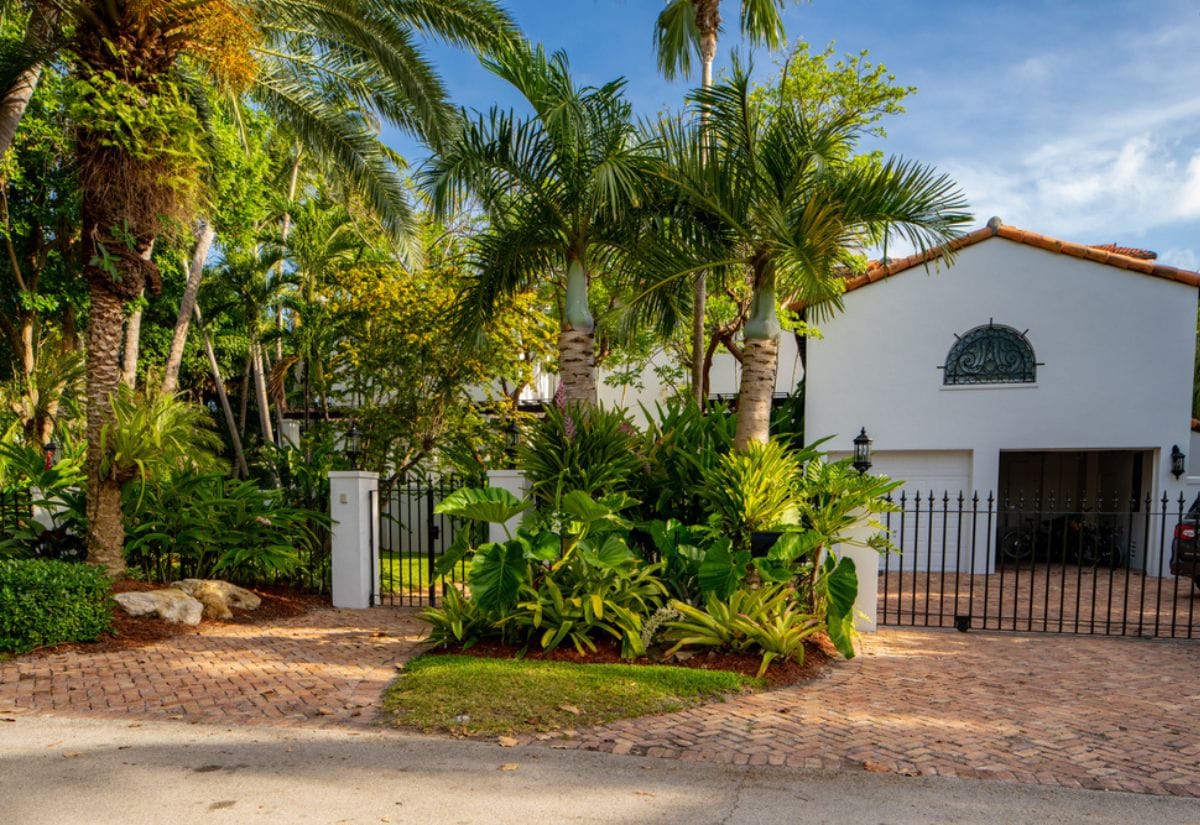
Let’s try an experiment: if I say, “Florida,” what tree springs to your mind? A palm tree, of course! Maybe a tall upright tree with long fronds or one with an arching trunk and fan-shaped fronds… But it’s a palm tree.
And this mental picture we have of Florida can inspire many a garden. But if you wish your Florida landscape project to look original, you will need to choose a palm tree that you can also find in Florida!
There are 12 palm tree species that are native to Florida. However, thanks to its warm and mild climate, the “Sunshine State” is filled with different types of palm trees of all shapes and sizes from many parts of the world. By “Florida palm tree,” we mean a variety which is typical of this Southern US state, the Gulf of Mexico – not necessarily a native one.
You are about to take a sunbathed and visual journey among the most beautiful palm tree species you can find in Florida. This way, you, too, can recreate that “Florida look” in your garden at the end of this article.
But before identifying and choosing Florida’s most popular types of palms, let’s understand the deep link between Florida, its inhabitants, its climate, and palms.
Florida and Palms
Why does Florida have so many palm trees? There are at least two reasons, one natural and one cultural. Florida has the perfect subtropical climate that many palm trees like. It is warm and mild.
It is near the sea, so temperatures don’t get sudden shifts. It is also well ventilated, and many palm trees like it. It is also very sunny, and we know that palm trees love the Sun!
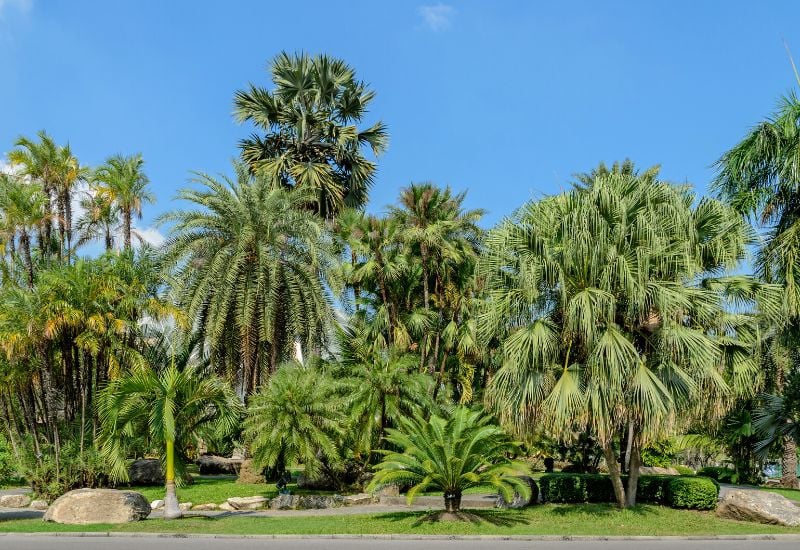
For this reason, Florida is home to many native species. Some are household names too, like cabbage palm, royal palm and dwarf palmetto. But then there is also another reason, which has “imported” new palm species to Florida…
Florida has built its image around the “summer hot climate” with “exotic elements, trees and animals”. So along with alligators, you don’t expect a fir, do you? There is a cultural identity that sees palms as typical of Florida…
And when gardens are designed, local palms and palms from other places are introduced.. And so many new, “foreign” palms have cropped up along the landscape in Florida.
Shall we check out the climate of Florida and where you live and compare them? It’s very important form palm growing.
USDA Zones, Palm Trees and Florida
To grow palms you need to be very careful about the climate you live in and the USDA hardiness zone. Every region is divided into what is called a “hardiness zone”.
This is basically tells you the temperatures that your climate gets. These are called USDA hardiness zones and you can literally check which zone you are in online.
These zones go from 1a, which is the coldest, to 12b, which is the hottest. But only Puerto Rico reaches zone 12 b and only Alaska goes below zone 2b… But you won’t even think about growing palms in Alaska… Most of the USA is contained within zone 3 (which is pretty cold) and zone 9 (which is pretty hot).
Florida is contained between zones 8 and 10 with the small area of Florida Keys in zone 11. Hawaii, California, Arizona and Texas have similar USDA zones. What you need to do is to make sure that the palm you choose lives in the USDA zone you have in your area.
Few palms actually go under zone 8 or 7, some get to zone 6. But this will cover most of the USA, excluding just the northern states. Florida palms may not bloom and fruit there, but they will still survive quite happily.
However, many gardeners have found a way round this: you can grow your Florida palms in containers and shelter them during the cold months. Of corse not all Florida palms are suitable for this, and in fact we will tell you which you can grow in containers in the article.
Now you know why palm trees love Florida and Floridians love palm trees, but what’s a palm tree?
Palm Trees in Florida and Beyond
Whether you live in Florida or not, a palm tree technically is any tree belonging to the family Arecaceae. However, in common parlance, we also add cycads to this group, sometimes called cycad palms. These are ancestral plants that scientifically are very different from palms, but they look like palms.
For example, cycads are gymnosperms, like conifers. This means that their seeds are “naked”, not enclosed. These are not flowering plants! Real palms of the Arecaceae family are angiosperms, which are flowering plants.
You will understand how the distinction between flowering and non flowering is huge for a botanist. But in garden centers you will often find cycads and real palms next to each other.
The list we have chosen has some native cycads too. We chose the gardening definition of palm, of course. What is more, we only chose non native palms that come from nearby areas that have permanently moved to Florida with one exception: red sealing wax palm. This is an extraordinary variety which will really add some spice to your garden.
But what’s so special about palm trees?
The Look of Palm Trees
Palm trees have some unique features that set them aside from all other trees. Let’s see…
Palm trees have no branches. This is arguably the most striking difference. They have single trunks and at the top they have leaves. In fact, the leaves of palm trees, commonly called “fronds” grow straight from the top of the trunk.
These fronds or leaves can have two core shapes. Pinnate leaves have a central rib and many leaflets on each side; these are long leaves. Palmate leaves instead have all the leaflets starting from the same point at the end of the petiole and radiating, often forming a fan shape.
Palm trees and cycads are evergreens. This means that they hold onto the leaves also in winter. When the leaves die, very often the remaining dried part forms a cover on the outside of the palm, like a winter coat. Sometimes not all of it, only the top. Other species have the whole trunk covered in dried leaves. In some cases, these form very decorative patterns.
Cycads and palms have some big differences. Cycads can have branches, for example, while palms don’t. On the other hand, palms have flowers and fruits, while cycads are more like pine trees… They have no flowers and they produce seeds without any fruiting body.
Identifying Palm Trees
The main identification elements for palm trees are the leaf or frond shape and size and the shape, size and look of the trunk.
They also produce flowers and fruits. But this may depend on the climate. For example you can grow a coconut or date palm tree without ever seeing a single coconut or palm in your life. This can be a matter of half a degree to cold a climate or even less.
So we don’t use flowers and fruits in identification. But in some cases these are so notable that we mention them anyway.
Fine, you know how to “palm spot” now, but how about growing palms? Are there any tips I can give you?
Growing Palms: Do’s and Don’ts
Palms are usually low maintenance and quite easy to grow. The main thing is getting the climate temperature right: palms are not cold hardy so be particular about the USDA zone.
Apart form that, palms want very well drained soil, but most species are adaptable to most types of soil, including poor soil.
One thing though… never prune a palm. You can’t keep them short if they are tall; cutting a palm means killing it. Don’t even bother with dry leaves! The tree will do everything itself. It will drop them when they are ready to and keep the part it wants to keep for protection.
Finally let’s dispel a myth: not every palm likes full Sun! Some tolerate and like partial shade and some even like full shade!
15 Stunning Florida Palm Tree Varieties To Elevate Your Landscape
And now that we have gone through all these important facts and tips, it’s time to set sail to Florida and see which beautiful palm trees we can find there! For your Florida-inspired garden or terrace, here are the best native and non-native palm trees types that grow well in the sunshine state:
1. Scrub Palmetto (Sabal etonia)
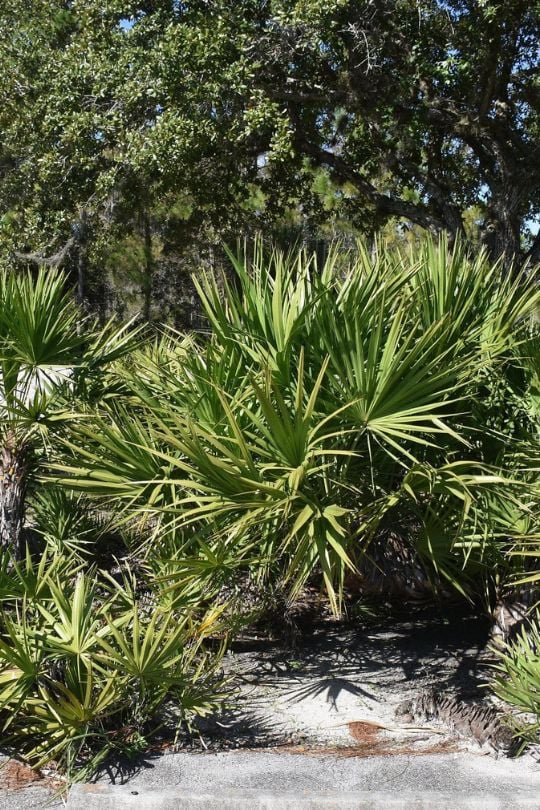
Scrub palmetto is a lovely small variety of palm you can find native in Florida and it has very special fronds. These are palmate and attached to a long and upright petiole. The leaflets are pointed and blade like, light green in color.
But if you really want to recognize it, look at the overall shape of the frond! Most palmate palms form fans that are roughly semicircles… Scrub palmetto forms and almost perfect disk instead!
Scrub palmetto is very architectural and decorative palm you can use as a specimen or in groups. It adapts well to both formal and informal garden designs.
2. Silver Date Palm (Phoenix sylvestris)
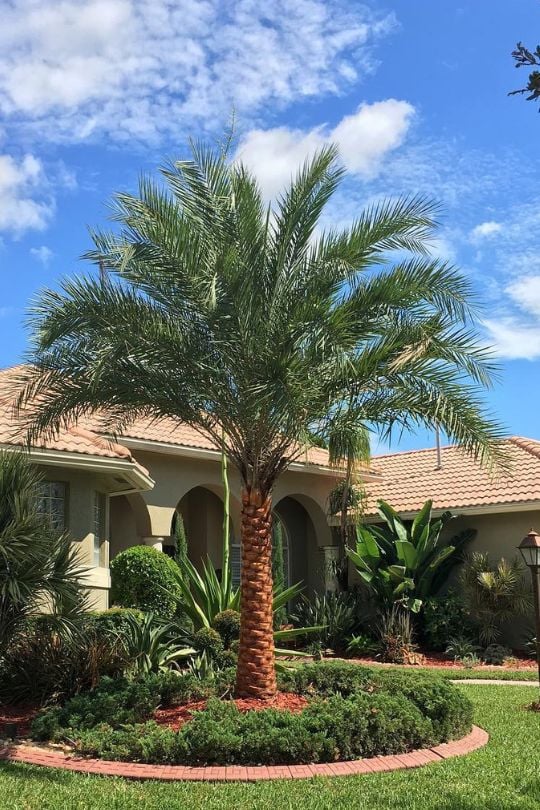
Silver date palm, a.k.a. sylvester palm is a medium to large sized palm tree with a large crown, excellent to crate shade. The top has long and arching pinnate fronds. These are very thick and they grow on top of a layer of preserved dry ones.
The trunk looks scaly and it’s fairly thick. On the whole it has a harmonic and well proportioned look, not a spindly one like many palms do.
Silver date palm is a wonderful foundation planting tree but also great as specimen at the end of a lawn, just before your porch or by a swimming pool.
3. Florida Keys Thatch Palm (Leucothrinax morrisii)
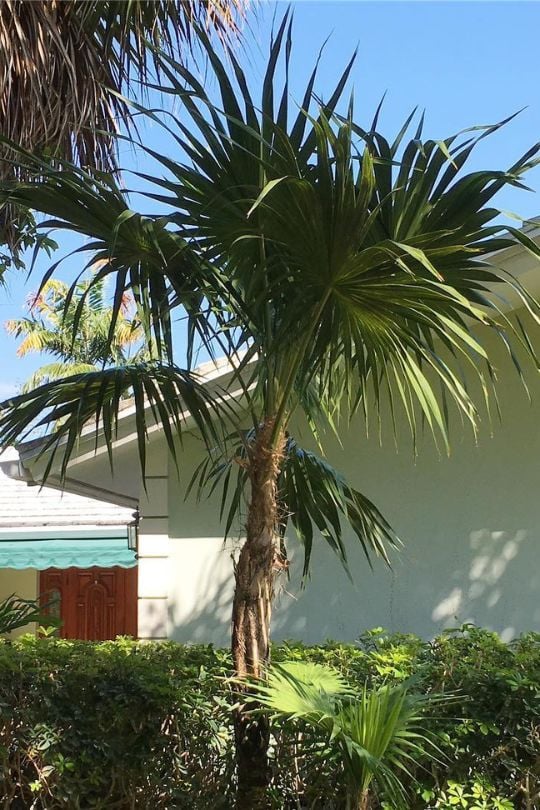
Florida Keys thatch palm is a native tree of that area of Florida and the Bahamas. You might have guessed from the name… It can be short or tall, depending in growing conditions.
The fronds are palmate and almost round in overall shape, or heart shaped. They form a round crown on top of the thin and fairly smooth trunk, with some pointing up and some arching down.
Florida keys thatch palm is an elegant tree I would see well growing as a specimen or in spaced clumps by lawns and as a poolside plant.
4. Florida Silver Palm (Coccothrinax argentata)
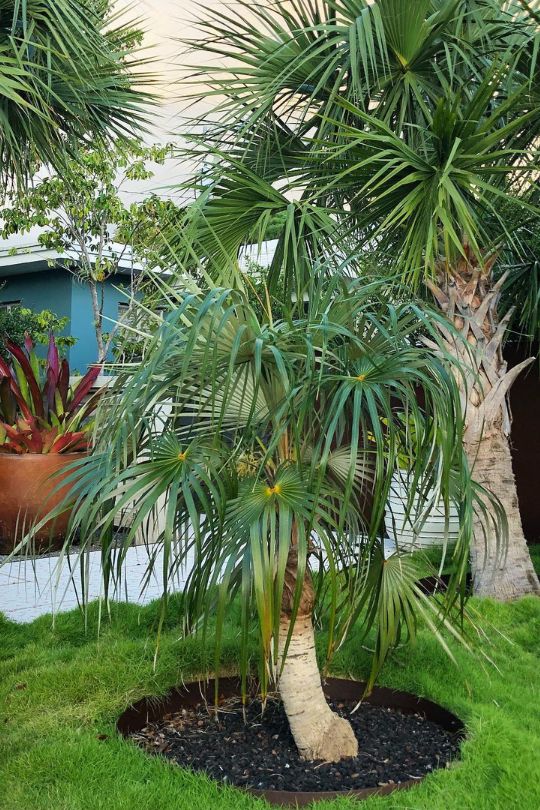
Florida silver palm is a classical tall and slender palm tree, like those we see in postcards. The trunk is smooth and upright, very tall and capped by a round crown of fronds which looks small in comparison.
The fronds are palmate and silver blue in color. This makes it easy to identify this species of Florida palms.
Florida silver palm is a classical looking tree which is great as foundation planting. It also looks good mixed in with other trees, but make sure that they aren’t taller than your palm – actually it’s better if they are just under its crown!
5. Paurotis Palm (Acoelorrhaphe wrightii)
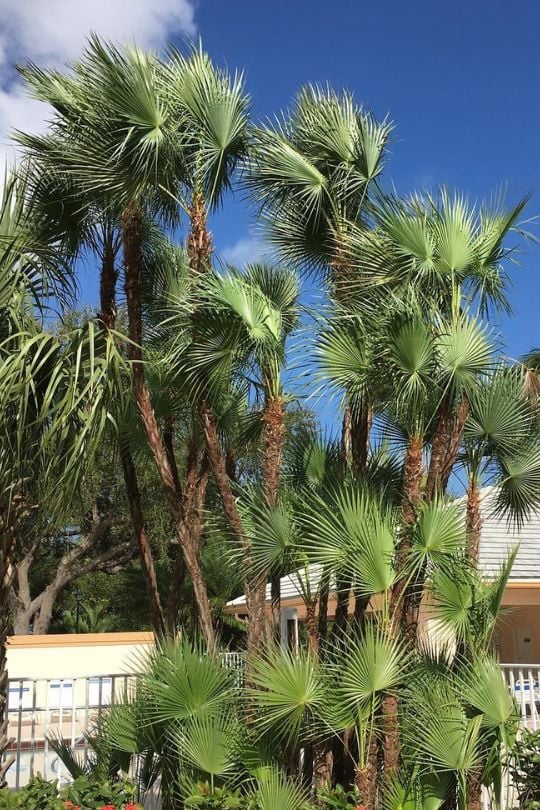
Paurotis palm is another classical looking Florida palm. It has bright green palmate fronds that grow on long and straight petioles. These look upright at the top, but they point out and even down lower down the crown. The trunk looks fibrous, a bit like coconut coir in appearance and it’s light grown gray in color.
Paurotis palm is elegant and slender, with a very upright habit. The fronds form a lovely texture, which will look great in an exotic garden.
6. Florida Cherry Palm (Pseudophoenix sargentii)
Florida cherry palm is also called buccaneer palm, and it really suits the “pirate island” look! It is a medium sized tree with elegant long and pinnate fronds that arch and twist at the top of the tree.
The trunk is slender, light brown in color, upright and smooth. It will not stand cold temperatures, so be careful about the climate.
Florida cherry palm is ideal for a tropical looking garden. It will adapt as a poolside tree or even in formal settings, but in my view a naturalistic design is best for this palm.
7. Foxtail Palm (Wodyetia bifurcata)
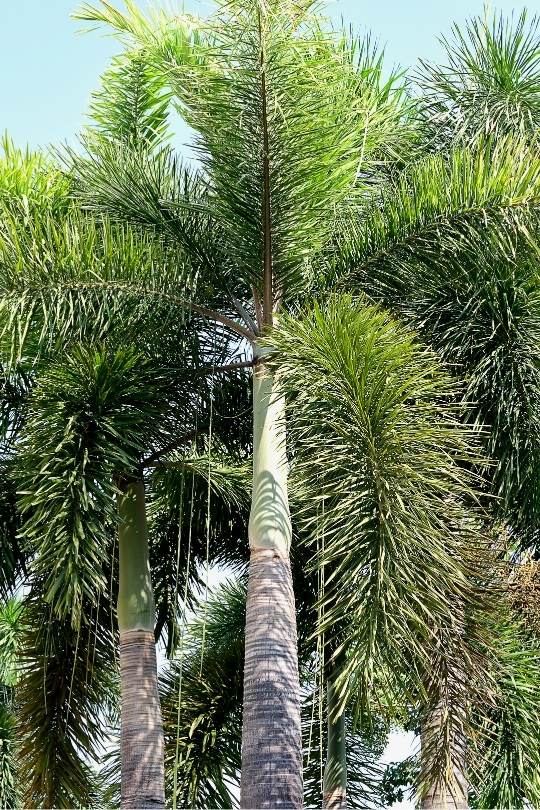
What a beautiful variety of Florida palm is foxtail palm! The trunks are fairly slender, almost white and tapering towards the top. The fronds are bright green, pinnate and arching.
The fact is that the leaflets don’t grow flat on the sides of the central rachis… They grow at different angles, giving the fronds a three dimensional quality. In fact, they look like the tails of foxes.
Foxtail palm is highly sculptural and very elegant at the same time. Everything about it makes it ideal for most garden settings. Just have a look at it and I am sure you will fall in love with it.
8. Red Sealing Wax Palm (Cytrostachys renda)
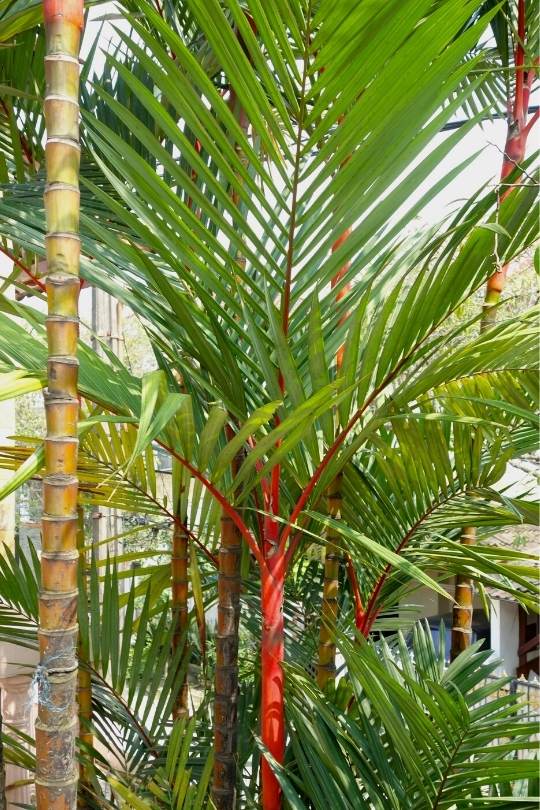
Red sealing wax palm is an import to Florida from Southeast Asia but I want you to see it… It has striking crimson red petioles and stems that make an impressive contrast with the bright emerald fronds! It’s a magnificent variety and a very unusual one… The fronds are pinnate and arching but with a rather flat tip. It looks like they have been cut in fact…
Of course you will want red sealing wax palm in a focal pint of your garden, and especially of you want to add energy and even drama to your green haven.
9. Cabbage Palm (Sabal palmetto)
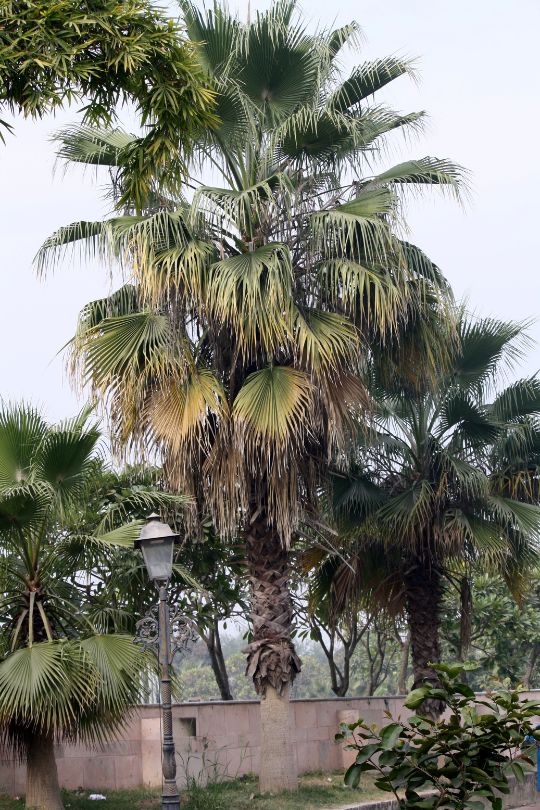
Cabbage palm is actually the official palm of Florida, the symbol tree of this state… It has a very classical look with very upright and fairly slender trunks. There are grooved horizontally, and they are gay brownish in color.
On top of the trunks you will find the globular crowns made of fan shaped fronds. The green ones will be nested above the old, dry and brown ones, which the plant preserves for quite a long time.
Cabbage palm is an iconic tree, very typical of Florida, so if you really want to design a garden inspired by this US state, you should really consider growing one!
10. Needle Palm (Rhapidophyllum hystrix)
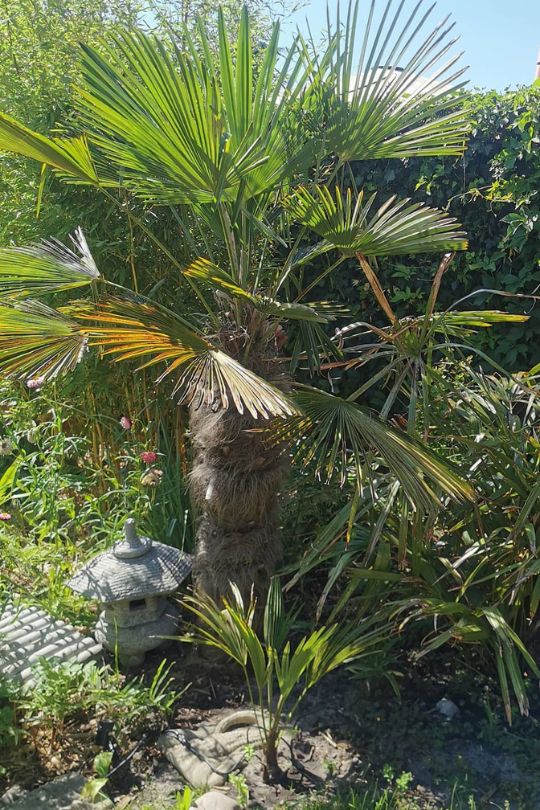
Native of Florida, needle palm has made its way into gardens all over the world. It is a small, dwarf variety with lovely and soft looking fronds. These are palmate, very regular in shape, with thing and long gentle leaflets that arch every elegantly.
They are deep green in color. The trunk is small and almost completely hidden by the foliage. In the end, though it is a tree, it looks like an exotic shrub.
Needle palm is ideal for a tropical looking garden, as backdrop or in clumps. And you are in luck! This palm is both cold hardy and it even grows in full shade!
11. Dwarf Palmetto (Sabal minor)
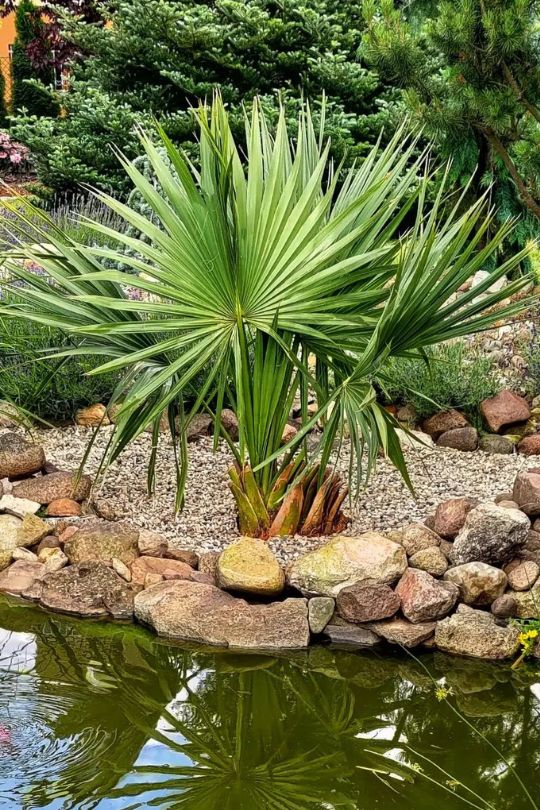
Dwarf palmetto is another small palm tree native of Florida. It has thin and long petioles that hold fan shaped green fronds. These look fragile, brittle and elegant at the same time. Some will point almost upward, while others will arch to the sides. The overall look is light and airy, rather than thick and dense.
Dwarf palmetto is ideal if you have a fairly humid garden or terrace. Unlike other palms, it likes damp and shaded positions. You see, there is a solution to all problems!
12. Florida Royal Palm (Roystonea regia)
Meet Her Majesty the Queen of Florida, aptly named Florida royal palm. Maybe the name comes from the massive size of the fronds, that can be 13 feet long (almost 4 meters)! This makes the palm worthy of a royal park and in any case gives it an impressive appearance. The emerald green foliage forms a fairly globular crown on top of very tall and straight.
The trunk is gray and smooth with stripes. At the top though, it has a very distinctive green part where the fronds are attached.
Florida royal palm is an imposing tree… It will look great in fairly large gardens. It can suit the tropical look but also the dry one. It can be grown in formal gardens as well, though it will be perfectly at easy in informal designs too.
13. Dominican Cherry Palm (Pseudophoenix ekamanii)
Dominican cherry palm is not actually native of Florida, but of the nearby Dominican Republic. So it has not had to travel much to reach the coast of Miami. But in gardening terms is is very decorative.
It has bulging “carrot shaped” trunks with dark and light horizontal zebra stripes. At the top, the fronds are few and pinnate, bright green in color, glossy and with a lovely fine texture.
It is ideal for exotic gardens, and in particular if you want a rare species. In fact, you can add Dominican cherry palm to your collection as a “prized plant” and you will be contributing to its preservation. Yes, because unfortunately it is critically endangered.
14. Saw Palmetto (Serenoa Repens)
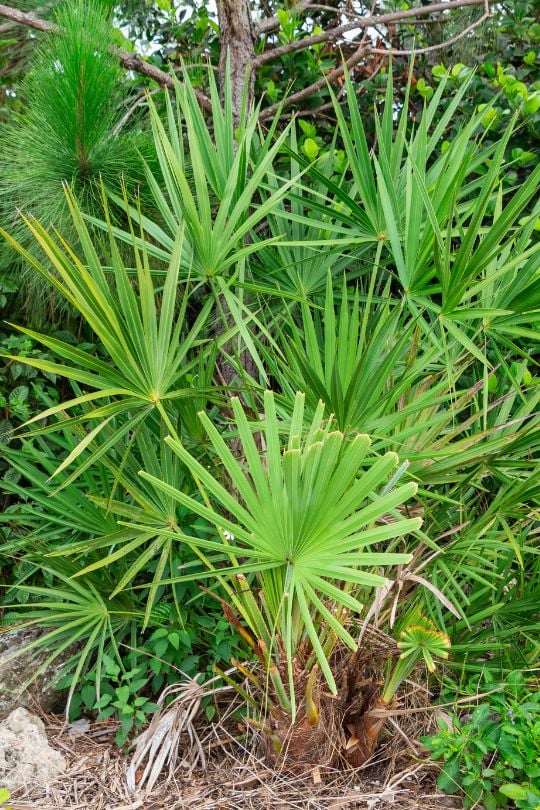
Saw palmetto is native of Florida and quite decorative and original. You will recognize it because the bright green palmate fronds have a special feature…
The leaflets are partly joint, to about half their length; then, the tips depart, giving it a “palmate foot or hand” appearance, like a duck… It’s a small and adaptable cycad, so it also is multi trunked.
It forms large clumps that really give you the idea of “tropical” and “Caribbean”, lush and green… It is also suitable to shady spots, so perfect as underbrush.
15. Queen Palm (Syagrus romanzoffiana)
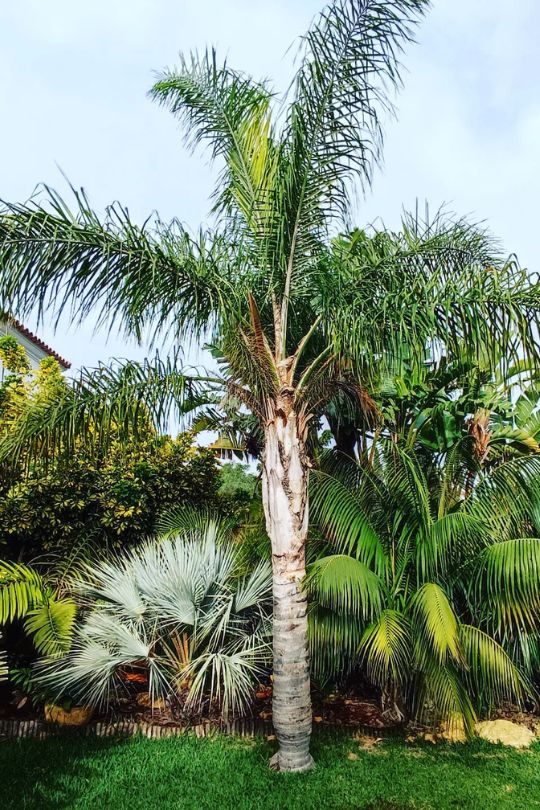
Shall we close our list of Florida palms with royalty? Queen palm too has aristocratic claims thanks to its impressive elegance. The fronds are long, arching and with bending leaflets. Each frond can have hundreds of these leaflets, up to 494! This creates a fine and delicate texture.
The trunk is upright and light colored. It is smooth up to a pint, then you have intersecting triangular remains of dead and dropped leaves that look like – guess what? The crown of a queen of course!
Queen palm is perfect for smart and elegant gardens, including modern ones, public parks and even minimalist designs.
The Special Look of Florida Palms
Palms have many more looks and personalities than people think. Some are more “desert oasis looking”, like date palms, others, like coconut palms scream out “atoll in the Pacific Ocean!”
Florida palms instead mix the sultry and moist exotic with the sunny and beachside look. There are 12 native species of palm trees in Florida, and a few that have made Florida a “home away from home”.
As promised, you now know which palms to choose if you want your garden to have that “Florida look”.
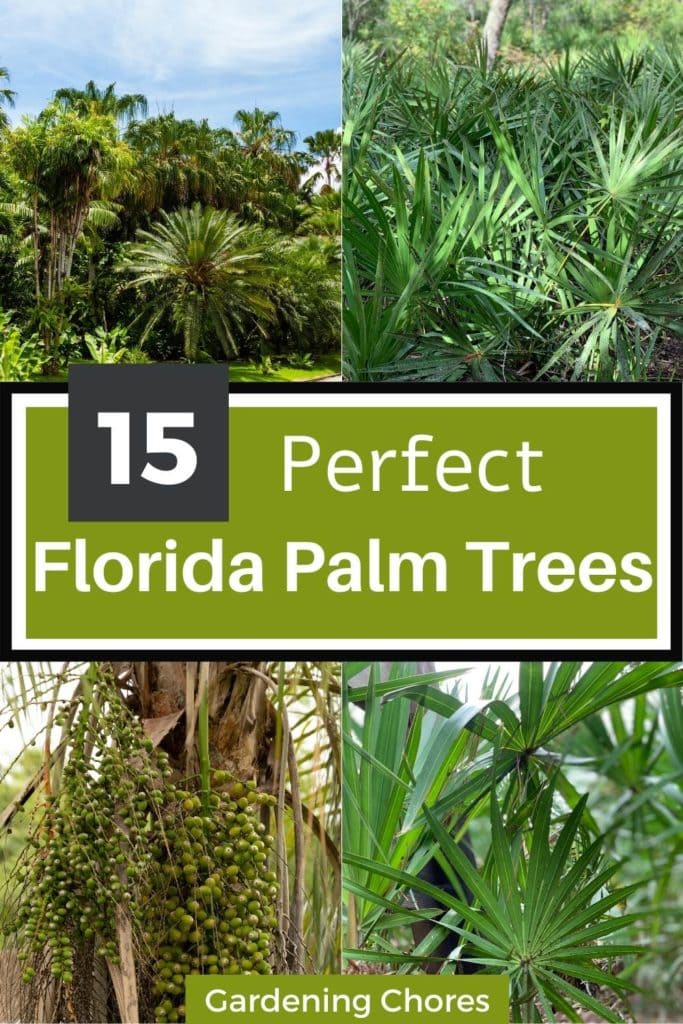

Written By
Amber Noyes
Amber Noyes was born and raised in a suburban California town, San Mateo. She holds a master’s degree in horticulture from the University of California as well as a BS in Biology from the University of San Francisco. With experience working on an organic farm, water conservation research, farmers’ markets, and plant nursery, she understands what makes plants thrive and how we can better understand the connection between microclimate and plant health. When she’s not on the land, Amber loves informing people of new ideas/things related to gardening, especially organic gardening, houseplants, and growing plants in a small space.

